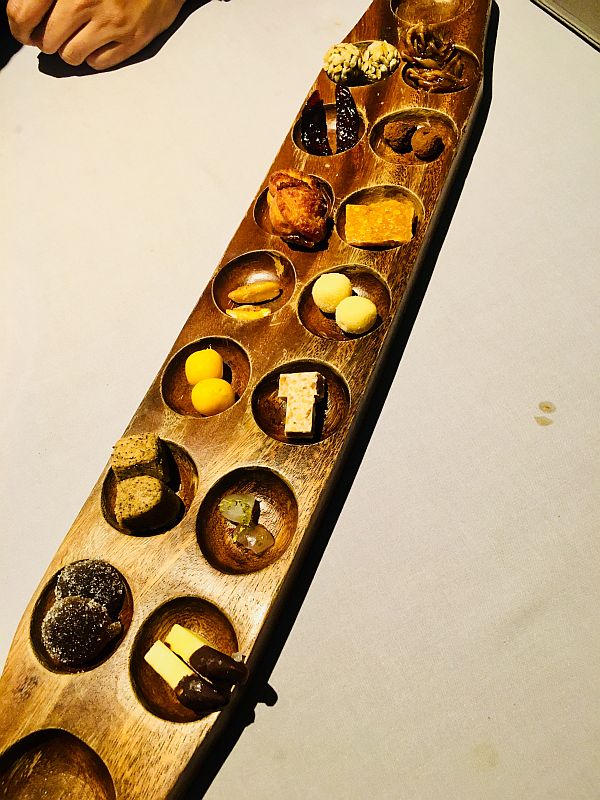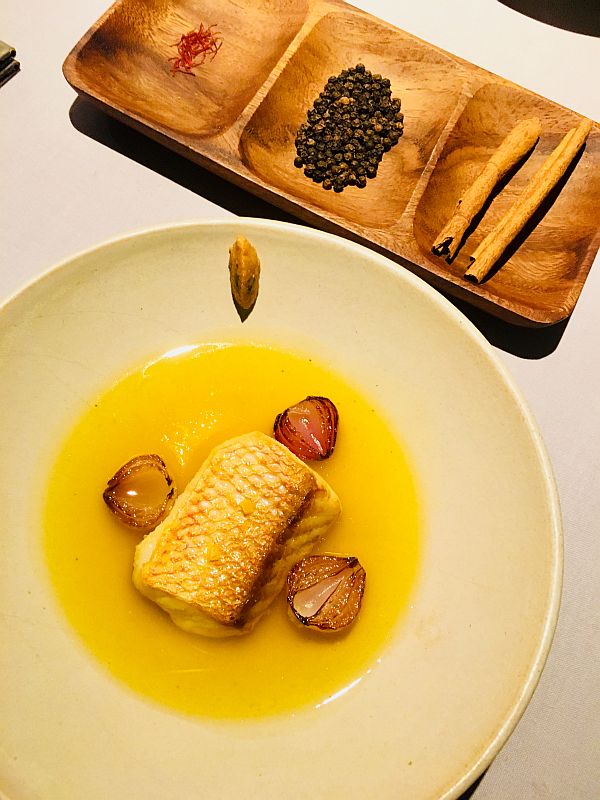
Sungka is the fun and playful suite of petit fours, inspired by popular sweet delicacies from across the archipelago, and these are served in tiny bite sizes on a sungka board.
MY SEARCH for new flavors in these parts took me, a few Saturdays ago, to the capital, after I finally got a reservation for a degustation dinner for two at Gallery Vask, the only restaurant in the Philippines that has made it to Asia’s 50 Best Restaurants list for two years in a row (Rank 39 and 35 in 2016 and 2017, respectively).
Situated on the fifth floor of Clipp Center in Bonifacio Global City, Taguig, Gallery Vask is an exclusive 20-seater fine-dining-cum-art gallery space (art pieces curated by Juan Carlo Calma), which serves two tasting menus—15-course Alamat and 8-course Lakbay—conceptualized and envisaged by Spanish-born Chef Chele Gonzalez.
Since I rekindled my interest in food and cooking, I have been looking for local restaurants that dare to be different, or are being run differently, restaurants that offer a new or fresh perspective, or point of view, whether they do local or international or fusion cuisine, but centered on new and sincere approach to flavors.

This first suite
of amuse-bouches from
the Lakbay tasting menu is called Binondo, which features 5 popular streetfood fare found on the streets of old Manila’s chinatown.
What Chef Chele does at Gallery Vask is something truly special, something I have never come across hereabouts. Calling it an anthropological cuisine, his food is inspired by his travels to various regions and local communities in the country, where he discovered stories and histories of various local cuisines; ingredients that are even unfamiliar to us, Filipinos, humble ingredients that we rarely see being used in local restaurants, not even in what they call native Filipino restaurants.
It piqued my interest on how a Spanish chef, who trained and worked at restaurants (restaurants I can only dream of going to for my apprenticeship) like Arzak, El Bulli, El Celler de Can Roca, and Mugaritz, can create or recreate familiar and not-so-familiar Filipino dishes, and bring to the forefront of a fine dining experience local flavors and ingredients, by both modern and traditional techniques.
We parked on the third floor of the building, where an elevator would take Enrico and I to the fifth floor. As soon as we stepped out of the elevator, a receptionist greeted us, and took us to the open-air balcony for our welcome drink.
A bartender gave us each a glass of salabat cocktail, a concoction of ginger juice blend, calamansi liquor, Don Papa rhum, and muscovado syrup. After a few sticks of cigarettes, we were led to the Gallery Vask dining room, and seated at a table that faced the open kitchen.

Lutong Bahay is the next suite of two amuse-bouches: Tinolang manok, and smoked sardines on rice crackers.
It was explained to us what the Lakbay menu was all about, the number of courses they were going to serve. Thus, our journey began, when a lady brought to our table two brown paperbags, each one containing a small-sized pan de sal.
This staple Filipino bread was paired with coconut salt and coconut butter. A few minutes after, came our first suite of amuse-bouches, which was aptly called Binondo, Manila’s old streetfood capital.
“Binondo” was a set of 5 small plates, containing re-imagined familiar streetfood fare: “okoy,” a pair of tamarind wood-smoked shrimps with ginger crème fraiche and soy gel; “kwek-kwek,” a 60C quail egg yolk with crispy sweet potato noodles; “egg-hipo,” a Chinese-Filipino dish with shrimp in salted egg mousse and fried curry leaf; wagyu chicharon with Pinakurat vinegar; and the star of this set, the torched senorita banana cue stuffed with savory foie gras mousse.
The next set of amuse-bouches, called Lutong Bahay, which paid tribute to Filipino homecooking, was served. “Tinolang manok” actually had no manok in it but tasted so much like our beloved comfort food with a different twist: the broth was emulsified with egg yolk and garnished with a dash of arosep to give it an ocean flavor.
It was paired with smoked sardines on rice crackers. Our next course was called Tiradito, a Japanese-Peruvian kind of ceviche that was widely popular in major cosmopolitan cities a few years ago. In his version of Tiradito, Chef Chele made yellowfin tuna kinilaw coated with coconut-calamansi thickened with kuzu. Arosep, pickled in Pinakurat, gave the dish some spicy and sour crunch.
This flavor combination prepared us well for the next dish, called Habagat, which to me was a whirlwind of flavors and aromas in my mouth: crab, upo seeds, ramram, lemon basil or sangig, Thai basil, fermented coconut and corn snow.
It was plated in a small bowl with dry-ice smoke. The most interesting part of the dish was the upo seeds, which gave a crunchy contrast to the layer of tangy and coconut flavors. 5.6 was one of my most-awaited dishes from this menu. But how did it get its numerical name?

500 is a red snapper dish inspired by a 500-year-old Moorish recipe, which Chef Chele learned about in one of his trips to Muslim Mindanao.
It was explained by the server that the dish was a fusion of flavors from the country’s regions 5 and 6: Bicol express and oyster, respectively.
The oyster was poached in clarified butter and calamansi juice, and then slathered in spicy coconut milk-based Bicol express sauce, and finished off with rabanos pickled in Iluko vinegar.
I have this strange way of cleansing my palate when having a multi-course degustation meal. After every other course, I would take a cigarette break while drinking my favorite sparkling water.
After the heady 5.6 dish, I went out to the balcony to puff a couple of sticks while ruminating on the flavors I just teased my palate with. When I came back, Enrico was wide-eyed thrilled when the next dish was served.
The fish dish called “500,” was Gallery Vask’s modern take on a 500-year-old Moorish recipe: red snapper in lemon-saffron sauce and almond-majada paste that when mixed in the sauce altered the whole flavor of the dish, altogether.
I read somewhere that Chef Chele learned about this recipe in one of his trips to Muslim Mindanao.
The almond-majada paste gave the dish a more contemporary flavor. It was like having a two-in-one dish, and time-traveling from our ancient past to the present. At this point it became clear to me that the whole gastronomic experience at Gallery Vask was a journey through various terroir and cuisines across the Philippines.
I was like introduced, for the first time, to the same flavors I’ve grown used to, and local and native ingredients, strangely and surprisingly, are as foreign to me as caviar and truffles.
The conceptual dishes were anything but contrived; I could sense the genuine appreciation of the chef for native flavors and his aspirations to elevate lowly ingredients to stellar roles on the fine dining table.
The next few dishes did make such impression, and we were no less than flabbergasted (finally, I got to use the word!).
“Routes” was a tricky dish: it had “cheeks,” kamote, pickled wild cucumber or pipinong-gubat (how this fruit found its way to haute cuisine was mind-boggling, to me, and I just started looking for this plant to grow in my small home garden), and gotu kola or takip-kuhol.
There was a guessing game after we tried the cheeks; the server asked us to name the animal the cheek was from.
Enrico said it was duck, because the texture and grain of the cheek looked similar to that of duck breast.
But ducks have such small cheeks, I said. I guessed beef, because it tasted like beef, but I knew it wasn’t beef, otherwise we wouldn’t have been made to guess.

Habagat is like a storm of flavors and aromas in your mouth: crab, upo seeds, ramram, sangig, Thai basil, fermented coconut, and corn snow.
Until we gave up and were told it was tuna cheek! My favorite parts of any degustation dinner are the amuse-bouches, starters and desserts. I am not a main-course kind of person, like I mentioned in my previous column.
One of my favorite desserts from this tasting menu was called Bato Pingol: an ensemble consisting of dalandan mousse, shards of dehydrated dalandan meringue, ginger ale granita, yoghurt and pili nuts.
The main element, and after which the dish was named, was the bato pingol leaf. When the dish was explained, we were told bato pingol was what Aetas of Pampanga normally ate with fish or simply with salt and chili.
It tasted like sour green apples. When the next dessert was served, I exclaimed, “We eat a lot of this in Cebu!” Pintos, or Cebuano sweet tamales, was corn pudding steamed and stuffed in corn husk, and came in with corn mousse, grilled corn and burnt milk ice cream.
Our dinner at Gallery Vask was finished off in grand fashion. It felt like the grand finale of an haute couture fashion show.
Our Lakbay tasting menu culminated with a fun and playful set of petit fours, all served on a sungka board, thus the name of the course.
Sungka had all these familiar sweets, with some new savory twists, from across the archipelago served in tiny bite-sizes: bukayo, chestnut with cocoa powder, peanut brittle, pastillas, nata de coco with calamansi zest, green mango dipped in dark chocolate, tamarind jelly, coffee polvoron, squash yema, cashew nut, coconut macaroons, cashew marzipan, tablea pinipig, and camia jelly.
